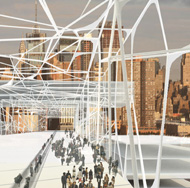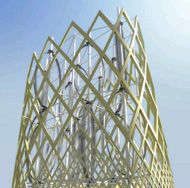Future studies and projects
As a result of its ambition to collaborate with the world of architecture and align itself with reflection on urbanization on the fringes of the commercial sector, Lafarge wants to offer new solutions for construction with a reduced ecological footprint and an enlarged social role. This is the key challenge in its partnership approach with the world of architecture.
"Living infrastructure" – a study of bridges |
|
 Case studyMarc Hatzfeld, sociologist and observer of suburbs |
"Living infrastructure": that is what engineer-architect Marc Mimram is offering in his study carried out in partnership with Lafarge. Generally poorly perceived, infrastructure is too often experienced as a necessary evil in cities. It is time to reconcile infrastructures and inhabitants! Four bridges, four cities Bridges, the ultimate infrastructure, lend themselves to the principle of this study. Marc Mimram proposes four innovative bridges suited to specific cities:
Lafarge and concrete in architectural thinking In the context of the study carried out by Marc Mimram, Ductal® ultra-high performance concrete appears to be the ideal physical solution for creating the engineer-architect's light and inventive forms.
View the exclusive interview with Marc Mimram in images! |
Hypergreen, the environmental tower of the future |
|
|
The Hypergreen project saw the light of day thanks to architect Jacques Ferrier. This 246-meter ecological tower complies with "sustainable building" criteria: environmentally-friendly materials, upgradeable construction techniques and everyday respect for the environment. The structural elements of the Hypergreen - the slabs, walls and columns - are conceived in Agilia®. This self-placing, self-leveling concrete reduces physical effort and noise pollution during the construction phase. It also offers superior esthetic qualities compared to traditional concrete. The "outer skin", a mesh which guarantees the stability of the building, is made of Ductal®, Lafarge's ultra-high performance concrete. This reduces the amount of raw materials needed for the construction and also reduces the total weight of the building.
A tower that meets its own energy needs
Hypergreen uses renewable sources to meet the energy needs of its occupants. For this:
A multipurpose tower Hypergreen offers over 94,000 m² of usable floor space. Encompassing all facets of urban life, it has room for shops, offices, apartments, green spaces, leisure areas and parking facilities. |
 A Ductal® meshHypergreen adapts to climatic conditions The "outer skin" of the Hypergreen tower is a Ductal® mesh which optimizes the passage of natural light through the building. This mesh adjusts itself in line with the sunshine, the wind and the weather. The northern façade allows the sunshine to enter while the southern façade acts as a sunscreen and protects against overheating. The mesh also channels air towards the wind turbines on the root and enhances the tower's ventilation. Finally, it ensures the stability of the tower and makes it possible to reduce the weight of the interior structure. Hypergreen in ParisThe Phare tower The Hypergreen concept is based on a specific proposal made in 2006 by architect Jacques Ferrier: the Phare tower. This project for a 300-meter skyscraper was proposed for the Paris-La-Défense business district. The subject is explored inMaking of - Phare & Hypergreen towers, by Jacques Ferrier, published in February 2007 with the support of Lafarge byArchives d'Architecture Moderne(AAM), Ante prima. |
Completed architectural projects |
|
|
To discover structures and buildings created with Lafarge products, click on the following links: |
|





